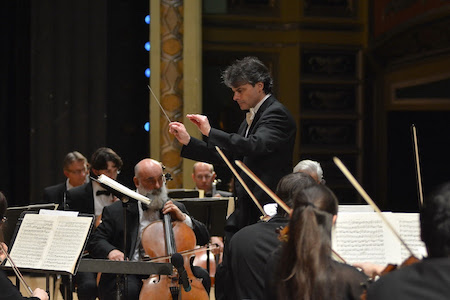by Robert Rollin

Saturday’s performance approached perfection. The second movement opened with principal oboe Cynthia Watson’s gorgeous performance of the hauntingly melancholy melody, soon answered with restrained expression by principal cello Michael Gelfand. After a full string statement and a piquant doubling of bassoon and French horn, the woodwinds entered and led to a full orchestra rendition. Principal bassoon Mackenzie Brauns’ outstanding solo followed others by clarinet and oboe. The student players were carefully choreographed, playing only in the tuttis, and the performance was remarkably sensitive and transparent.
The Scherzo opened almost inaudibly. Woodwinds soon joined the strings, and solos in oboe, flute, and clarinet culminated in piccolo solos that sparkled over the two orchestral sections. The brass finally entered playing gentle background staccatos. The entire movement had an elegance that belied the number of performers.
Sheer volume came into play in the strident Finale, with the students augmenting the fortes, where Tchaikovsky added substance and intricacy with background triplets and multiple percussion. The ensemble was impeccable.
The performance of Edward Elgar’s “Enigma” Variations flowed beautifully. The theme — the product of an improvisation — moved directly to the variation portraying Elgar’s wife. A thin texture grew to full tutti followed with strong solos by principal horn Stacie Mickens and principal oboe Watson. Variation II rapidly alternates strings and woodwinds. III includes light woodwind solos and colorfully doubled cellos and bassoons.
Elgar added brilliant brass to the full orchestra in IV, and joined V and VI together with playfully fragmented ideas. After beginning with very soft strings and principal clarinet Alice Wang’s lively solo, VII moved speedily to a fortissimo climax. VIII features gorgeous writing for bassoons and clarinets. IX (“Nimrod”), an adagio depicting Elgar’s editor, includes beautiful cello solos and high clarinet against dark, sustained string basses.
X features soft, fast twitterings to mimic Dorabella. XI employs flashy string and woodwind colors to depict Elgar’s friend’s bulldog falling into a river. XII and XIII included short attractive cello solos by Gelfand and syncopated, throbbing drums. The powerful and mercurial Finale, depicting Elgar himself, adds brass and percussion for a rousing conclusion.
The performance of Debussy’s Prelude to the Afternoon of a Faun was colorful and sensitive. Principal flute Kathleen Schaffer’s intense opening solo led to beautiful two-harp accompaniment, expressively paired horns, a sparkling oboe solo, and full strings. The flute theme returns seven times in different guises, subtly delineating what Debussy called the faun’s “dreams and desires in the heat of the afternoon.”
Published on ClevelandClassical.com April 24, 2018.
Click here for a printable copy of this article



